To learn about the LION experiment please start with this video and look for any other related videos on the MFMP YouTube channel.
Kanthal A1 'flake' transmutations in the LION 2 reactor heater?
In the non-magnetically separated LION 2 sample set analysed, there was a flake similar to the material encrusted on some sections of the Kanthal A1 heater wire.
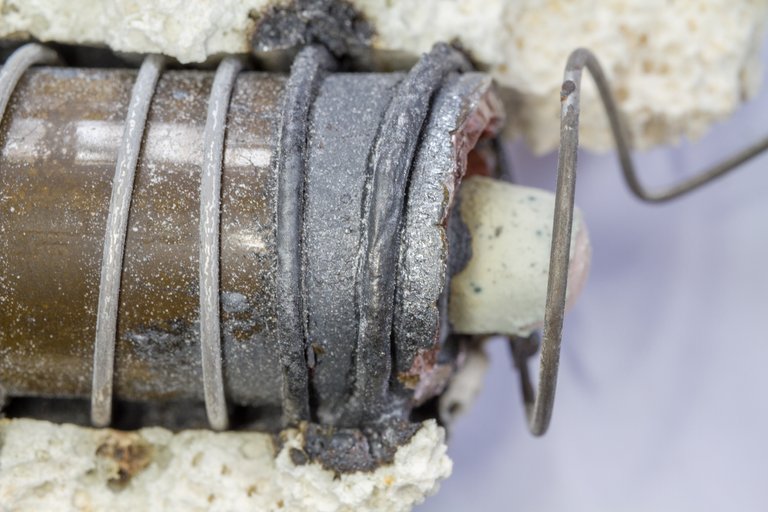

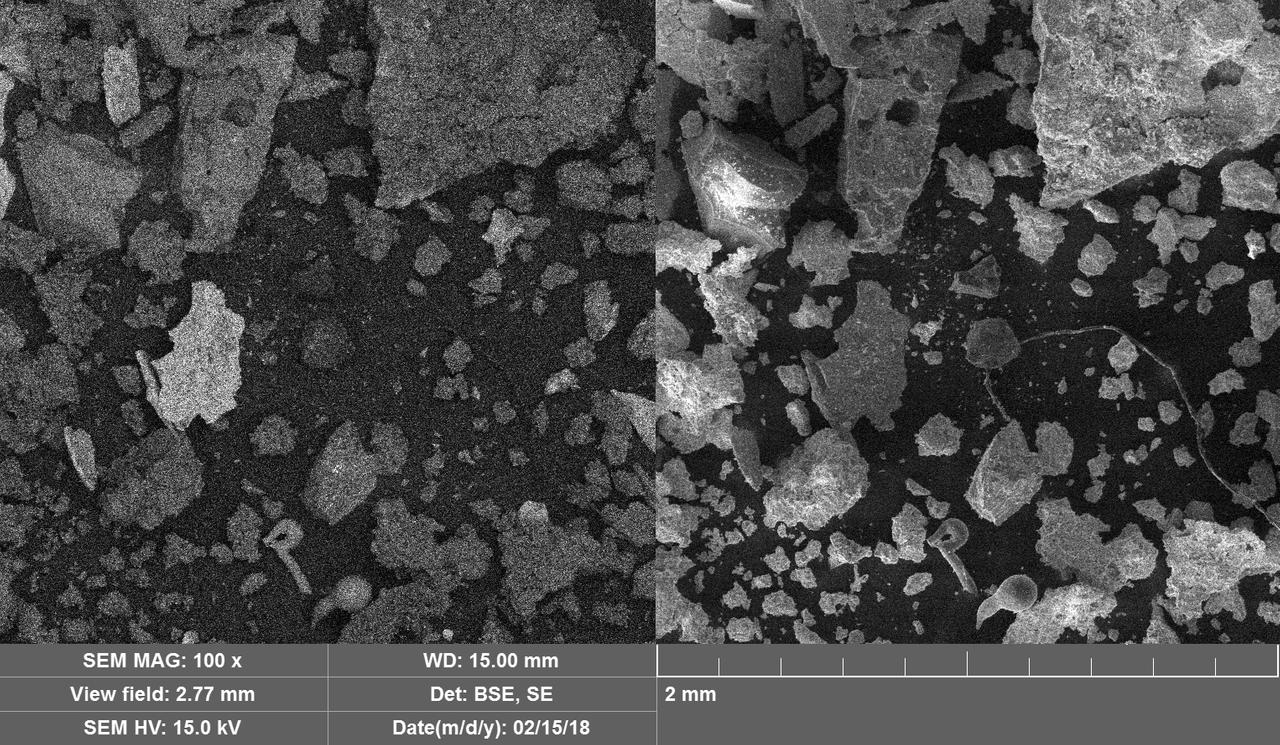
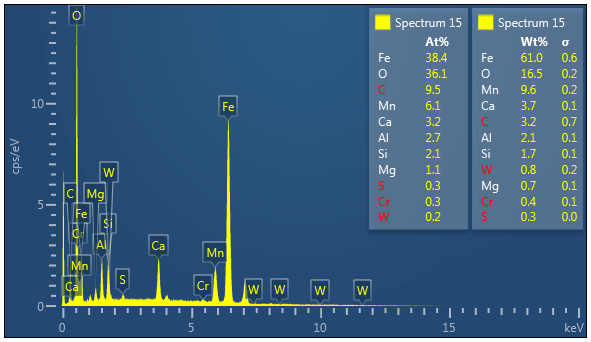
High levels of Manganese?
| Element | Atom % | Weight % |
|---|---|---|
| Fe | 38.4 | 61.0 |
| O | 36.1 | 16.5 |
| Mn | 6.1 | 9.6 |
| Ca | 3.2 | 3.7 |
| Al | 2.7 | 2.1 |
| Si | 2.1 | 1.7 |
| Mg | 1.1 | 0.7 |
| Cr* | 0.3 | 0.4 |
*Included despite being below confidence level because it is in Kanthal FeCrAl alloy
The data from all other samples 10 through 18 except 15 had no manganese in at all, some other much smaller samples studied later in the SEM session did detect Mn but below the microscopes confidence threshold, so this was the only sample area out of 33 that contained Mn with confidence. Note that Chromium is detected but the amount is so low that it is shown in red, meaning that it was also below confidence.
This high mass % of Mn was unexpected, since no other materials or feedstocks tested to contain Mn. One thought was that it could be part of the makeup of the heater wire since the flake looked like it came from there and it was the only bulk source of Fe in the reactor (there was minute contamination in the alumina reactor core). We therefore reached out to to Lookingforheat.com to establish if the wire used contained any manganese. We were sent this reference from which the chart below was captured, we were told that the wire type used was Kanthal A-1.

From the given source, the Kanthal A1 heater wire was claimed to be Mn free. However, on further investigation, we found another source, from Kanthal themselves, that did report that Kanthal A1 could contain up to a very low %age of Mn.
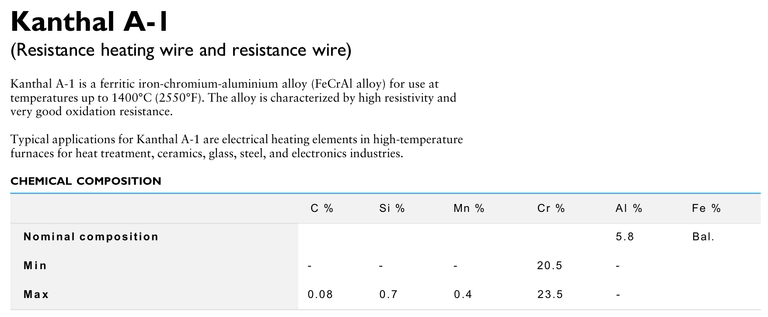
In this case, for Kanthal A1, they claim that it can contain from 0.0 - 0.4% Mn. This is far lower than we observed however. If we compare only the elements in Kanthal A1 and those equivalent found in the 'flake' to a worst case scenario derived from Fig 6, ie maximum Mn and minimum Cr (ignoring Silicon and Carbon), we get the following comparison
| Element | Kanthal A1 Atom % | LION 2 'Flake' Atom % | % (Loss) / Gain | Before / After |
|---|---|---|---|---|
| Al | 5.8 | 5.7 | (0.1) | 0.98 |
| Cr | 20.7 | 0.6 | (20.1) | 0.03 |
| Mn | 0.4 | 12.8 | 12.4 | 32.00 |
| Fe | 73.1 | 80.8 | 7.7 | 1.11 |
To 1 decimal place, 20.1% of total atoms were lost from Cr which is equivalent to the 12.4% Mn + 7.7% Fe atoms gained. Not only is the overall composition change indicative for deuteron driven transmutation, the diminishing atom % increase between Mn and Fe indicates that there was still room for more activity in this reactor fragment. This reaction pathway was suggested as a desired approach by Dr. Stoyan Sarg in his 2013 book "Structural Physics of Nuclear Fusion", content is re-produced here with the authors permission.
Since the process, in this authors opinion, is not that of particle collisions but implosion, one can discount all other reaction products normally associated with high energy particle physics and just concern ourselves with the main isotope + Deuteron fusion product and net release of binding energy. The resulting reaction pathways are given below.
| iso | % 2dp | p | n | +2H > | Half-life | Decay | Go to | MeV | Note |
|---|---|---|---|---|---|---|---|---|---|
| 50Cr | 4.35 | 24 | 26 | 52Mn | 5.591d | β+ | 52Mn/ 52Cr | 13.58 | (1) |
| 52Cr | 83.79 | 24 | 28 | 54Mn | 312d | EC 99.99% | 54Mn/ 54Cr | 13.27 | (1) |
| β− 2.9× 10−4% | 54Fe | (1) | |||||||
| β+ 5.8× 10−7% | 54Cr | (1) | |||||||
| 53Cr | 9.5 | 24 | 29 | 55Mn | stable | na | 55Mn | 17.27 | (2) |
| 54Cr | 2.37 | 24 | 30 | 56Mn | 2.58h | β− | 56Fe | 13.11 | (1) |
| 52Mn | synth | 25 | 27 | 54Fe | stable | na | 54Fe | 18.68 | (1) |
| 54Mn | synth | 25 | 29 | 56Fe | stable | na | 56Fe | 18.19 | (1) |
| 55Mn | 100 | 25 | 30 | 57Fe | stable | na | 57Fe | 15.61 | (1) |
| 56Mn | synth | 25 | 31 | 58Fe | stable | na | 58Fe | 18.38 | (1) |
| 54Fe | 5.85 | 26 | 28 | 56Co | 77.23d | β+ | 56Fe | na | |
| 56Fe | 91.75 | 26 | 30 | na | |||||
| 57Fe | 2.12 | 26 | 31 | na | |||||
| 58Fe | 0.28 | 26 | 32 | na |
(1) National Nuclear Data Centre Q-Value calculator
(2) Structural Physics of Nuclear Fusion, Stoyan Sarg, Page 100
Note that there are no neutrons in these processes, even if the reactor is stopped early. It would appear that the process favours first conversion of all lower mass isotopes before progressing, as there was no cobalt detected. It appears the reaction has not progressed beyond Fe which is unsurprising given the amount of Mn still available.
Looking at the magnetically separated core fragments
During the live streamed break up of the LION 2 fused core, Bob Greenyer seperated an amount of the core material using a high strength Neodymium based magnet. He speculated at the time that the parts collected may be fragments of the heater coil since that had iron in it.

Interesting things observed here, that will be discussed in other blogs, are the aluminium/silicon alloy pieces and the carbon fibres, both of which appear to have been gathered up by the magnet sorting process. It has been noted that Carbon can be made magnetic as can Silicon.. If this is happening in the LION reactor, then how it is happening, might be related to the overall process.
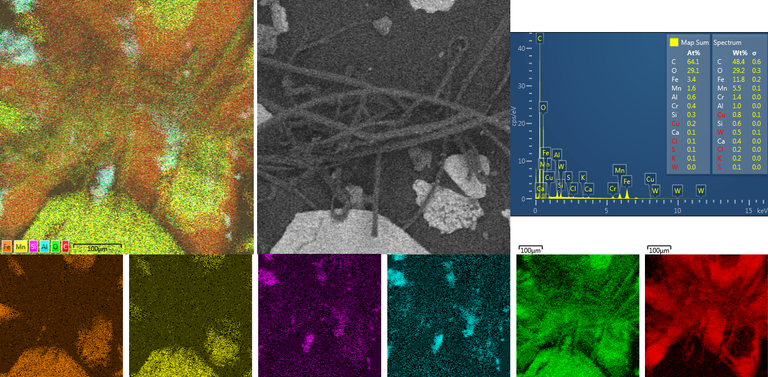
Here we can see multiple flakes of high concentrations of Manganese coincident with Iron. The Mn atomic concentration is approaching half that of Fe, this could be because more pre-cursors leading to Mn are being synthesised, Fe may be progressing to Cu or W or the relatively lower melting point of Mn with respect to Cr and Fe means there is some surface concentration, therefore more investigation, both radiation monitoring as part of replication and the immediate period afterwards and further analysis techniques on the ash need to be conducted to confirm these potential findings.
Options for confirmation
There are several options for confirming the presence of transmutations above, some are very sensitive to both the time that the experiment is run for and the amount of time after it has concluded before detection is used. During the experiment it is unlikely that particles or photons will be detected due to the potential confining nature of the active agent.
Detection of beta due to 56Mn > 56 Fe decay (2.58h half life). CCD (Cosmic Ray Finder), Cloud Chamber with magnet / Dentafilm with magnet / Geiger Muller pancake tube. Immediately put affected Chromium metal into detection device. Measuring a 2.58 hour half life would represent very strong evidence.
Detection of 52Mn > 52Cr via positron+electron annihilation resulting in twin 511KeV photons (5.591 day half life), must stop reaction early and detect immediately as 52Mn will be quickly converted to 54Fe and there is only 4.35% 50Cr as feed stock to start with. CCD (Cosmic Ray Finder), Cloud Chamber with magnet / Dentafilm with magnet / Geiger Muller Pancake / NaI scintillator.
Detection of high concentration of 57Fe via ICPMS, TOF SIMS, TIMS or Mossbauer spectrometry
Detection of none or nearly no Chromium and high concentrations of Manganese by EDS in areas that started out composed of high concentrations of Chromium.
Signs of 'Implosion Technology'?
The apparent progression of elements towards higher Z numbers could be called fusion or it could be referred to as implosion. The word ‘fusion’ has connotations of high velocity particles smashing into one another, essentially as two body-events. When one thinks about the word explosion, the image of some chemicals or nucleons being torn apart in very short time-frames to occupy larger volumes comes to mind. The time frames for Dynamite and Uranium/Plutonium based detonations are extremely and mindbogglingly short respectively. In effect they appear almost as a collective action. There are ways to to burn or decay and release the same potential energy very slowly however.
Implosion technology might also occur very slowly, effectively one controlled event at a time, such as potentially in organic life forms, something discussed below. Could it be made to occur in such a short time frame that it would appear as a collective implosion?
One researcher, George Ohsawa, conducted experiments with carbon electrodes in air and underwater and the work has been replicated over the years by companies like 'Quantum Rabbit', at universities like Texas A&M with John Bockris and by individuals like George Egely. Typical assumed reaction paths for observed transmutations are given in the table below.
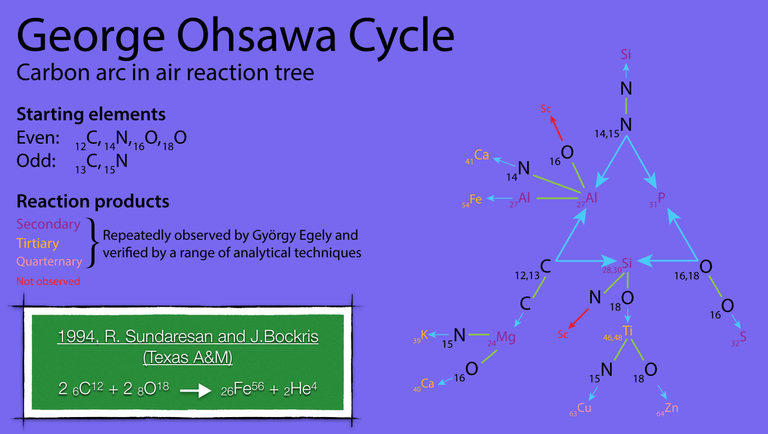
In the above figure 9, two different paths to isotopes of Iron are given. In the reverse direction, Alberto Carpinteri of the Polytechnic of Turin, Italy explored previous Soviet work on neutron emissions during and after earthquakes and found that during brittle fracture of iron rich rock, iron appears to split into aluminium (based on fracture plane analysis) releasing neutrons in the process. Presumably not 54Fe, but isotopes 56Fe and above are the cause of the neutrons.
Other evidence of transitions to and from iron and implications
John Hutchison's MFMP aluminium sample 18 - 'Coral'
John often started with Aluminium billets and bars as they appeared to be most readily influenced by his process which often had an Alpha/Beta emitter in the form of a rich Uranium ore, 1 or more approx. 500kV sources around 15ft from the active area and a plethora of low, milliwatt range RF interfering sources. In a study of one such Aluminium sample acquired by the MFMP, 'spheres' sitting in the centre of a cavities were analysed using SEM/EDS.


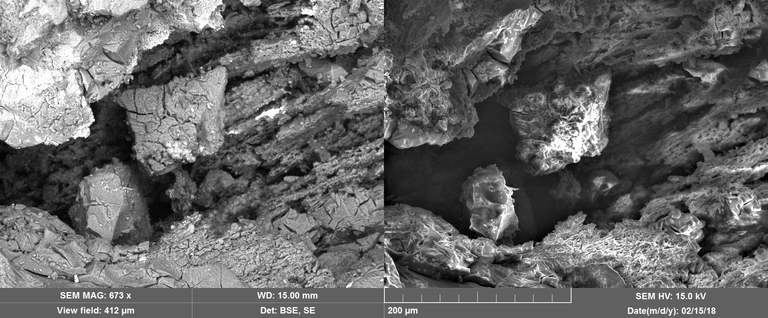
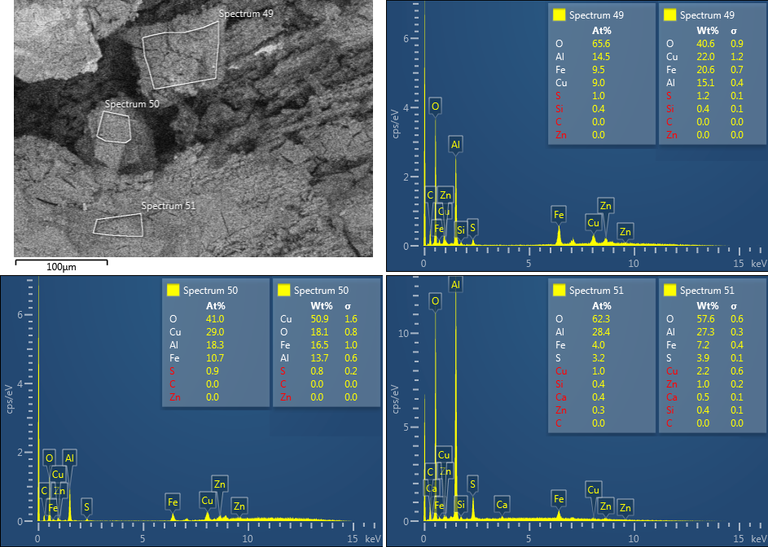
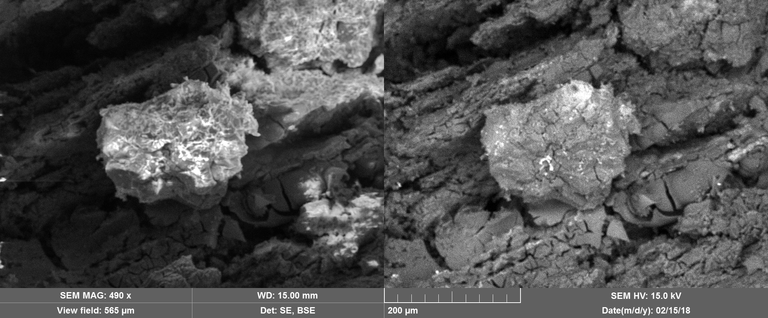
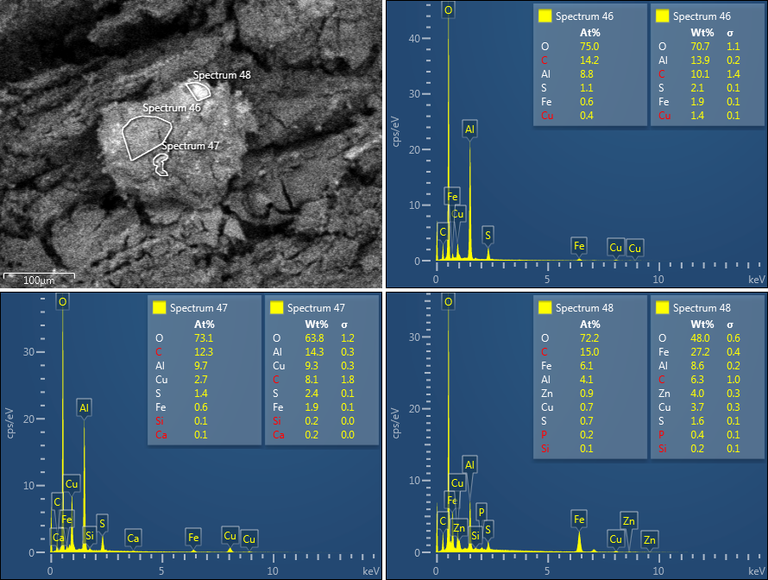
What is the Hutchison MFMP sample 18 data showing?
It would appear that the main transformation in these samples is from Al to Fe>Cu>Zn where the 2 x 27Al jump to 54Fe, as in the George Ohsawa reactions above, might be a the key transition before the subsequent stepwise transitions through to Zn.
In this analysis, for each 'sphere' tested:
- Al is always present when Fe detected
- Fe is always present when Cu detected
- Cu is always present when Zn detected
- No other reaction products other than those easily explained by George Ohsawa reactions of Aluminium in air are present
The above observation supports the notion that the elements detected are not contamination, but due to transmutation in the path Al>Fe>Cu>Zn.
Hutchison samples have been described as not necessarily self-quenching. Perhaps this may explain the presence of Sulphur, Phosphorous, Silicon and Calcium - all in the George Ohsawa reaction family, with products resulting from access to air. It may be that the active agent is continuing to transmute the air at the metal surface, forming a crust of these other synthesised elements.
Use of an in-situ ion-beam SEM with EDS will enable the removal of progressive layers from these ‘spheres’. The hypothesis that interactions with the air are forming a transmuted crust would suggest that, as the outer layers are removed, the inner layers would have higher concentrations of Fe, Cu and Zn.
Thinking inside the box
Below is shown a table of atomic volume which is defined as an element's atomic weight divided by its density. On this chart, marked in red, are elements observed by at least 3 labs in LENR experiments from 16 labs collated by George Miley and presented in 2009. Many of these same elements have been observed in samples from ECCO fuel, foil and ash (Suhas Ralkar), AURA (me356), NOVA (George Egely), LION and John Hutchison. Additional elements observed by MFMP over and above those identified in Miley's work are shown in green.
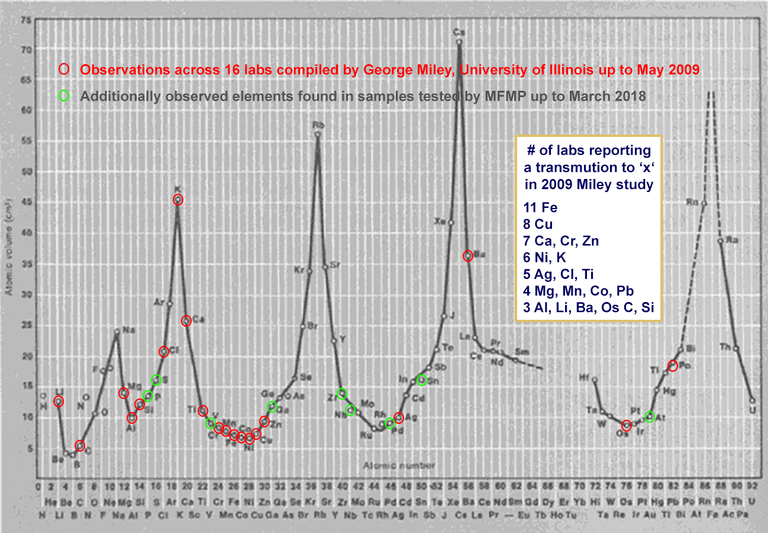
In the transmutation data collected by George Miley from international labs up to May 2009, 7 saw Cr, 4 saw Mn and 11 observed Fe, so the LION 2 data is not without multiple precedent. In addition, 3 labs observed production of Osmium, a fact that we will come back to later.
Piantelli and the dangers of Titanium and Vanadium and the high energy protons
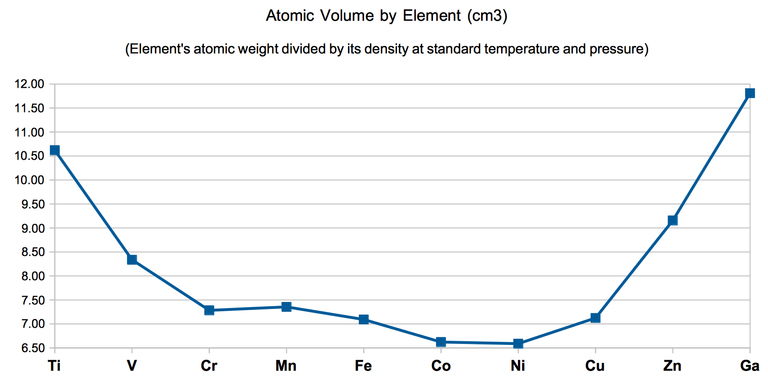
If you look at the above table you can see there is much to be gained in packing density by starting with Titanium or Vanadium. Indeed many researchers started with Titanium because of the ease of forming its hydride. Last year we reported that the reason for Prof. Francesco Piantelli's and Prof. Segio Focardi's et. al. 1994 highest ever excess heat and neutron production, was due to Piantelli's empirically observed high energy protons interacting with 50V, leading to a standard particle reaction that produced neutrons. This was nothing but words back in 2015, but the MFMP observed potential production of Vanadium in the ash of two independent systems, ECCO from Suhas Ralkar in India and AURA from me356 in Europe and we had to take the potential risk seriously as me356 had claimed to have observed neutrons at high levels as had other researchers using Titanium.
Piantelli when presented with a reaction table by the MFMP commented that it looked right but that his understanding had moved on from then, stating that it is 'nuclear reorganisation'. This authors hypothesises therefore is that the process could be ejecting spare protons during nuclear reorganisation.
Stanislav Adamenko's group at the 'Proton-21' lab in Ukraine performed high intensity electrical discharges into small, pure metal targets. The process transmuted elements first time and in 100s of subsequent experiments over 6 years, with stable products resulting from the process, regardless of the the stability of the initial nuclei. On p.154 of his book 'Controlled Nucleosynthesis', published by Springer, 2007, he proposes that, due to the strong compression of the active region, 'all interacting nuclei are "decomposed" into separate nucleons', forming 'a giant electron-nucleus macro-cluster', spontaneously formed nuclei in this structure that are stable long enough, can be ejected (if energetically favourable). Of course, there is no more likely and stable element nucleus to form than a proton!
Could it be that when there is insufficient proton carrying capacity in newly formed heavier isotopes, spare protons are just 'spat out' of the active agent. Higher Z number elements and heavier isotopes have more neutrons than protons. If this is indeed the case, one could suggest that the longer the process goes on for, the more protons would have to be shed when large scale re-packing occurs. This could finally explain the 0-6.7MeV protons observed by Piantelli.
If these protons are ejected in the course of a packing balancing act, then aggressive driving of the reaction or moves to heavier elements would result in more fast protons that could result in standard particle collision reactions with other fuel or structure of the reactor similar to that observed by Piantelli and Focardi in 1994. Fast proton activated processes might also explain the claims of both Andrea Rossi and me356 that if the technology is driven too hard, neutrons are observed
The ultimate extension of this process would be the formation of a body purely consisting of neutrons.
Stoyan Sarg's 2013 proposal for using 2H in a Cr>Mn>Fe reaction
In Stoyan Sargs 2013 book, titled "Structural Physics of Nuclear Fusion", he lays out the case for a Cr>Mn>Fe with Deuterium being a very favourable reaction path using his "Basic Structures of Matter-Super Gravitational atomic models" and many other widely available properties.
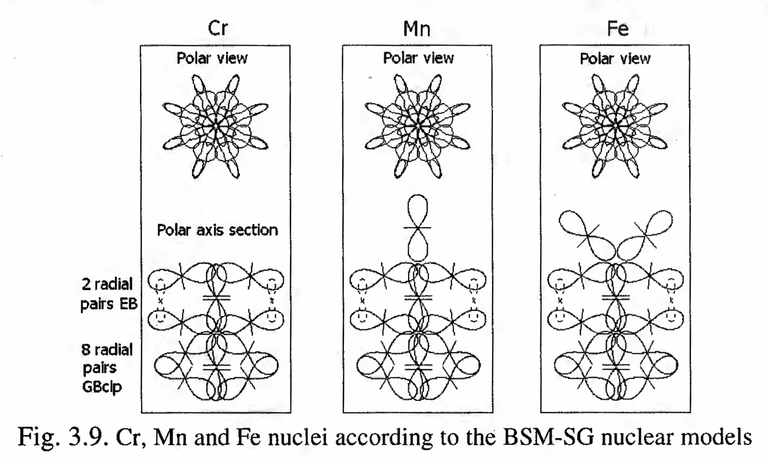
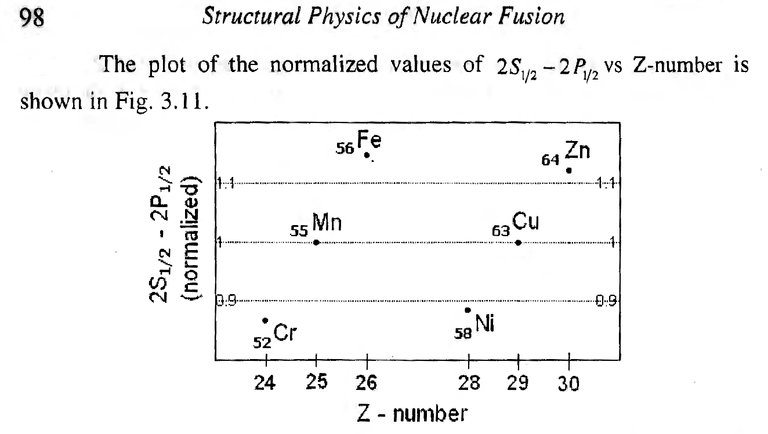
The plot in Fig. 3.11 also reveals some additional information on the similarity between the Cr-Mn-Fe and Ni-Cu-Zn trends . The trend slope of Cr, Mn and Fe group is steeper than the trend slope of Ni, Cu and Zn. This is so despite the fact that the difference between 52Cr - 55Mn is 3 neutrons , while the difference between 58Ni and 63Cu is 6 neutrons. The nucleon difference between the Mn - Fe and Cu - Zn is the same - one neutron. The trend slope is proportional to the change of the binding energy . Consequently, this change in the Cr , Mn, Fe group is greater than in the Ni, Cu, Zn group. On one hand , this is a confirmation of our hypothesis about the existence of GR field microcurvature around the nucleus, because the steeper change of the binding energy means a steeper change of the space microcurvature . On the other hand, this means that the nuclear reaction Cr + H -> Mn (Cr +D -> Mn) will require a higher temperature for triggering the fusion, but may deliver a higher energy output in comparison to the reaction Ni + H -> Cu
He concludes that the path Cr>Mn>Fe would be more suitable than Ni>Cu>Zn but that the triggering temperature will be higher, however, the work of John Hutchison indicates that once the active agent is made, maintaining and driving it does not require high temperatures.
Biological transmutation of 55Mn to 57Fe by Vladimir Vysotskii and Alla Kornilova
In the late 1990s - early 2000s, Ukrainian Vladimir Vysotskii and Russian Alla Kornilova established that when using yeast and bacteria cultures in a favourable growth medium, they could cause stepwise transmutation of elements, where it appeared that the elements were being shifted by hydrogen nuclei present in the growth medium.
To demonstrate this was a real process beyond doubt, they conducted experiments using manganese, which naturally only has 1 isotope, 55Mn in heavy water. The expected reaction product would be 57Fe and that is only 2.12% of natural Iron. Moreover, 57Fe has a particular nuclear magnetic resonance signature that would allow them to know that the transmutation has occurred. In years leading up to the 2011 report, they established that the use of a range of cultures could overcome the hypothesised 'auto-intoxication' of single cultures leading to much stronger transmutation rates.
The total, relative number of 57Fe nuclei that was created was about 10^17 nuclei per 1 g of grown and dried biological substances, which is between 10 and 20 times more than the comparable, relative, maximal number of 57Fe nuclei that is created in “one-line" grown and dried cultures. The total mass of 57Fe isotopes that is created is about 10^−5 g per each g of dried biological substance. The efficiency has increased, in particular, because the association has been allowed to grow during a 20 day period. “One-line” cultures cannot be grown for such a long period of time in heavy water because of “self-intoxication” of the medium by the metabolic products (in our former experiments the “one-line” Escherichia coli culture was grown during a 72 h period).
The data was derived from Mossbauer spectrometry and confirmed using Thermal Ion Mass Spectroscopy (TIMS), the data for which is mirrored below for brevity.
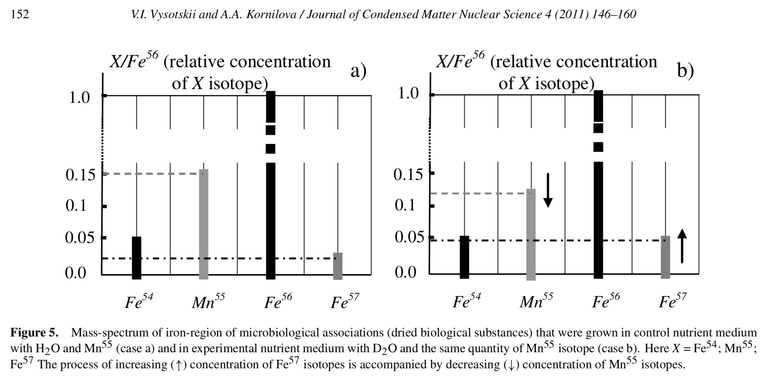
They have now repeatedly used this technique with light water to transmute 137Cs, one of the most damaging radioactive by-products of Uranium fission reactors, to stable 138Ba, something reported during ICCF-20 in Sendai Japan. This repeatable work with good controls conducted by Vysotskii, Kornilova et. al. over several decades means that both protium and deuterium can be fused into heavy elements biologically.
Since ICCF 20, the MFMP has been laying the ground work to conduct a replication of Vysotskii, Kornilova et. al. and the big sticking point was getting hold of some single isotope 137Cs. Naturally there is only one isotope, 133Cs. Vysotskii informed us that 137Cs will not be transmuted if there is any 133Cs in the mix. This supports the hypothesis that the process tends to favour transmutation of the lightest isotope first.
Is there proof of excess heat?
As of 22nd March 2018, there is no unequivocal evidence that the LION protocol is able to produce excess heat. It has been claimed to do so, even self-sustaining for days. In third party control tests to date by LookingForHeat.com and the MFMP, we have been unable to even get close to the kind of bulk transformations that removed masses of silicon from the Quartz liner and changed the structure of the Alumina. In addition, to date there have been no signs of the 'double vortex' and ring/track marks seen.
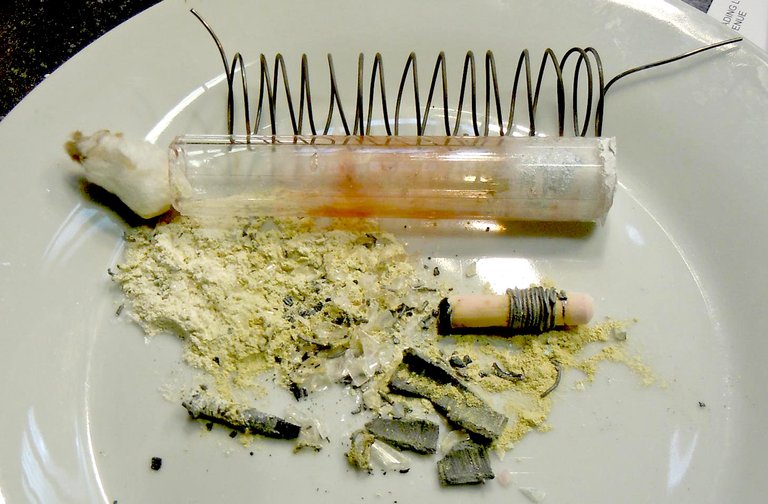
The 36V 11A DC power supply used in the LION experiments can supply a maximum of 396W, Alan Goldwater has determined that there is typically a 6 watts parasitic load, probably due to the cooling fan. Since the remaining 390W is divided between the two haves of the reactor (active and control), then the maximum power that can be supplied to one side, assuming there are no other losses, in 195W.
Based on the physical evidence alone, it appears that something that would normally take high heat appears to have happened. If the whole reactor was insulated, the reactor could exceed the melting point of Kanthal A1, however most of the Kanthal appears intact, which should melt at 1400 °C whilst the CuO (1,326 °C), SiO2 (1,710 °C) and Al2O3 (2,072 °C) have all been disrupted, perhaps chemically. Since Kanthal wire is itself protected from oxidation via a layer of Al2O3, one wonders why this was not removed by any chemical process that might have acted on the rest of the reactors structure and insulation.
Could it be that there was a large ejection from the Kanthal A1 of high kinetic energy protons or alpha particles, that deposited their energy in the alumina surrounding the heater wire?
Practical applications of non-novel, obvious derivative embodiments of the LION technology
In 2012, Yasuhiro Iwamura of Mitsubishi Heavy Industries reported that they had used a technique repeatedly to transmute various elements using deuterium gas.. This work was replicated by Technova, a division of Toyota. Here is a table based on their work and the proposed reactions they believe they observed.
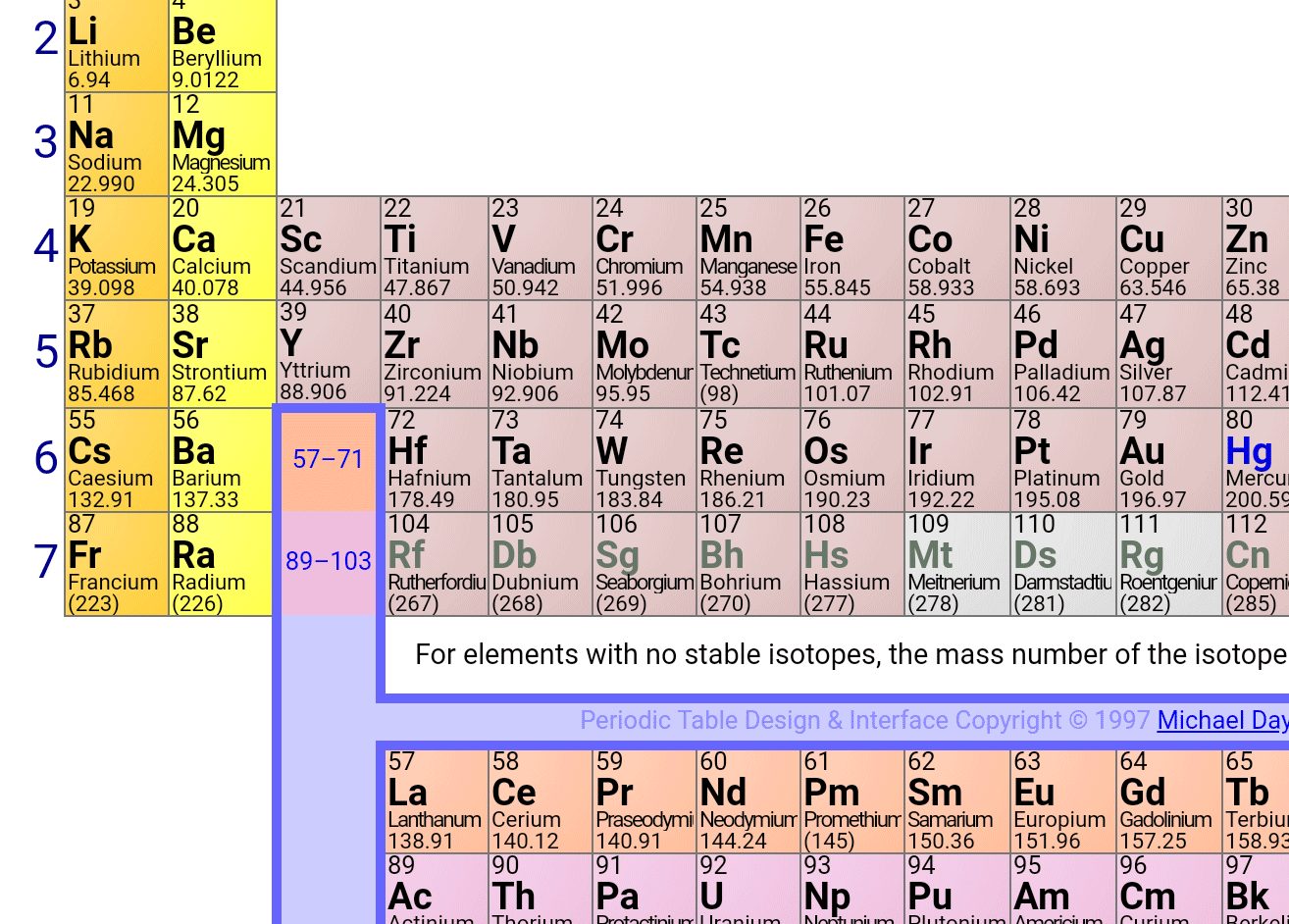
Removal of radioactive 137Cs & 90Sr from nuclear waste and contaminated areas
The two most dangerous element isotopes that come from uranium fission reactors are 137Cs because it acts as potassium in living things and 90Sr because it acts as Calcium and so can get fixed into bone mass. Both have half lives of around 30 years and so being able to be held in the body makes them most dangerous to humans and organic life in general. As has been shown above, Vysotskii, Kornilova et. al. have demonstrated the biological remediation of 137Cs repeatedly using syntrophic cultures of bacteria and yeast. Also, Mitsubishi and Toyota have shown that stable isotopes of Cs and Sr can be transmuted in a technological way by apparent addition of deuterons. Furthermore, it has been shown by S.V. Adamenko that transmutation pathways prefer production of stable isotopes regardless of the stability of the original isotopes.
Since the LION 2 reactor appears to be adding Deuterons in the Cr>Mn>Fe route, it could be possible to leverage this technology to remediate nuclear waste and potentially provide energy in the process.
This could represent a multi-billion dollar critically important industrial use regardless of net energy production.
Production of Osmium and Platinum from Tungsten
Osmium is the densest naturally occurring stable element on earth, which in this authors view makes it a likely target for implosion technology. It has a density approximately twice that of lead. If a variation of the LION protocol were used where the heater wire was replaced by Tungsten and the reactor ran in an inert atmosphere (to prevent the degradation of the tungsten wire) then it may be possible to repeat the findings of Mitsubishi and Toyota.
If so, then both Osmium and Platinum have good industrial uses as well as being valuable products. In this way there is a potential for the experimenter to make ash that is far more valuable than the cost of the starting materials.
Discussion
Lion 2 may have shut down after a number of claimed days long self sustain because a part of the heater coil degraded beyond the point at which it could carry current, when the reaction stopped maintaining the temperature in balance with thermal losses and it fell below the PID set point, no resistive heating could be supplied and the reactor continued to cool down. This raises a few questions:
- Must the Kanthal being transmuted carry electric current to trigger the effect?
- Does the Chromium containing metal need to be in electrical contact with the source of the active agent?
Whatever the answer to these questions, it does appear that the system can 'burn itself out' at these scales, which should be reassuring to any budding experimentalists.
It is this authors opinion that the Chromium must be preferably in metallic or alloy form rather than as an oxide or other compound, in order for the active agents to 'infect' the metal via the conduction band and perform their function.
Conclusion
The LION 2 reactor appears to have been transmuting Cr found in the Kanthal A1 heater wire, via addition of Deuterons through Mn to Fe. If so, this represents a high nuclear transmutation yield process that begins with easily obtainable, safe, off the shelf elements and industrial materials with the products not able to have radioactivity of any kind after the 50Cr is imploded to stable isotopes. Further study of other pieces of heater wire / flakes need to be conducted with mass spectrometry and magnetic resonance techniques to confirm this finding via determining isotopic concentrations, especially 57Fe.
If confirmed, this technology has the potential to form the basis of a multi-billion dollar nuclear waste and contamination treatment industry that is much needed, especially for those living around the pacific given both Fukashima and Enewetak Atoll. It also may be able to synthesise commercially important elements profitably making it a desirable experiment for first time LENR researchers.
For those interested in an open working New Fire reactor becoming available, please consider a PayPal donation here or via our MFMP Donation page where your name will be recorded in the record of donors.
The project looses 4.5% on Paypal donations, so for those that can do a direct bank transfer, donations of any size can be made direct to Quantum Heat C.I.C.s (the organisation that runs the MFMP) bank account here, thus saving charges:
BANK: HSBC
Branch Address: 153 North Street Brighton, East Sussex, BN1 1SW
Account Name: Quantum Heat C.I.C
Sort Code: 40-14-03
Acc No.: 12631571
IBAN: GB48MIDL40140312631571
SWIFTBIC: MIDLGB22Or bitcoin: 1JesTRUXU8jHb1haa1MoF2NvrU8gt5msCr
If you would like to help the volunteer researcher that produced this blog article and conducted the analysis work behind it, you can donate directly here.
Alternatively there is a US 501.c3 that also supports the goals of the MFMP, you can request information on how to contribute by that route by writing an email to [email protected]
Regards @mfmp
Several things happened:
(1) The MFMP conducted a whole series of tests in past years on the conductivity of Alumina and other refractory oxides to test their conductivity changes. Of course the Nernst lamp worked on this principal.
A. The LION reactors are cycled to around 800ºC, though they may actually be a little hotter due to the offset position of the thermocouple and pitch variation on heater windings. We found that the resistance of alumina started to drop much more after 1000ºC
B. Due to the nature of the active agent being thwarted by impedance mis-matches, having a material that changes its resistance may actually be beneficial and allow for transport of the active nucleated core structures to other parts of the reactor in a controlled manner.
(2) The Kanthal was very sparsely spaced - yes there will be some thermal gradients and in much of LENR research that has proved to be a good thing and would be most relevant to the heater coils themselves. In the case of heating the LIONs core, the Kanthals output will be averaged by the fused Quartz, then the Cu and its oxides and then the Alumina core.
(3) The quartz is a cylinder and in analysis tested as quartz. The most interesting and relevant study we have found was this one where a heated quartz cylinder was exposed to Cu in oxygen at an even higher temperature for a long period.
An analysis of the LION 1 bolt (same type as used in LION 2) revealed that it contained 0.5% Mn by weight, over 19 times less than observed in the LION 2 flake above.
More testing needed to rule out concentration as discussed.
Da Phys on ECW asked the following question.
The clarification behind the phrase would first rely on the data observed in the field. The most important is that 11 out of 16 labs that were surveyed in 2009 by George Miley had found Fe. In addition, we found it in NOVA and Hutchison samples and many groups have observed it in George Ohsawa experiments - so it appears to be the easiest metal to observe in LENR which means that it is highly favourable to synthesis. Given its position in the energy per nucleon /stability / atomic volume, then any system trying to pack more into a small box would favour its production.
Therefore, the hypothesis is that whilst there is any significant Mn (or Cr) available then nucleon re-packing would favour that element moving towards Fe. To move from Fe is only energetically favourable if say a deuteron or alpha particle is re-packed with the Fe, but even still, if there is any Mn (or Cr) it would favour re-packing with them first. In addition 4 labs surveyed by Miley observed the production of Mn, and Vysotskii and Korlinova specifically observed Mn>Fe so this path is not without precedent.
Once ALL of the nucleons are Fe, then, if there were more D atoms available, the hypothesis would permit progression from Fe through Co to Ni>Cu>Zn
Since there is potentially a little Cr left and plenty Mn, much more atomic volume efficiency can be gained by moving to Fe. In these steps, there is no requirement for EC or proton ejection to establish stable atomic nuclei, which makes it highly desirable from a safety stance.
It is suggested that the traces of Cu and W in the samples below certainty, could be due to progression from Fe - say with the addition of an Alpha in the first case or re-packing in the second. Since W lines can be confused for Si in EDS, this would need analysis by WDS or Mass spectrometry to confirm however it is unlikely as it would suggest that the packing jumped an atomic volume well.
Hello bob,
Alan Smith and Alan Goldwater are replicating LION reactors. Did they find any excess heat?
As said in this article, we have no idea if there was excess heat produced in the LION reaction. We have been told that the LION 2 self sustained for a number of days and we have been unable to produce the same effects in controls to date though there is some similar colour change observations have been seen in Copper interactions with quartz in the presence of air.
Our Hutchison samples show that equivalent transmutations to those observed in the LENR field can occur at room temperature so it may not be necessary to have heat or high heat throughout the process.
The LION author wishes to conduct further testing before handing over prepared cores, so the best we can do is conduct dummy runs, something that is in process.
In this way, only LION himself can reproduce the effect. . . . . .
We managed to replicate Celani with his wires. We managed to replicated claimed effects by Rossi with our own attempts as have others. Let's see if we are able to replicate even before core handover.